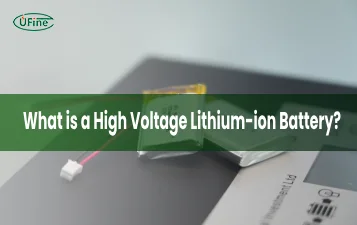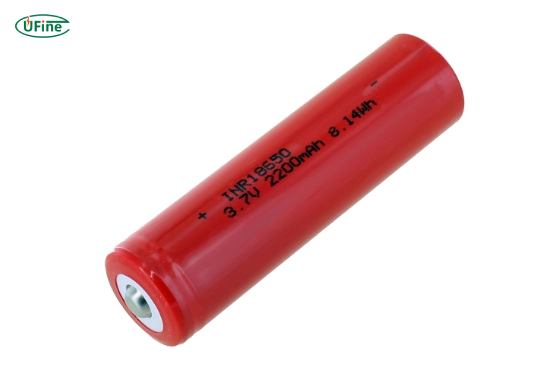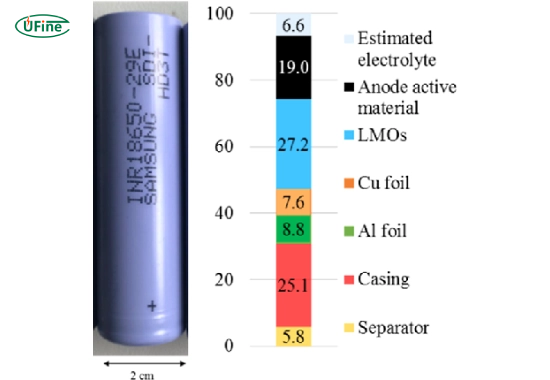What is an INR18650 battery and why is it the preferred power source for modern technology?
The INR18650 battery is a lithium-ion rechargeable cell with high power, safety, and long cycle life. It is one of the most commonly used battery formats worldwide and is found in electric vehicles, power tools, medical equipment, and consumer electronics. Its balanced performance and advanced chemistry make it a top choice for manufacturers and hobbyists.
This article provides a comprehensive guide to the INR18650 battery. We will explore its chemistry, technical specifications, benefits, applications, and how it compares to other battery types. If you want to understand why INR18650 batteries are so widely used and how to choose the right one, this guide is for you.
Part 1. What is an INR18650 battery?
An INR18650 battery is a cylindrical lithium-ion cell that combines nickel, manganese, and cobalt (NMC) in its cathode material. The name “18650” refers to its dimensions: 18 millimeters in diameter and 65 millimeters in length. The INR prefix stands for:
- I: Lithium-Ion
- N: Nickel-based chemistry
- R: Round cell
INR18650 batteries are known for their excellent thermal stability, high discharge rates, and reliable cycle life, making them suitable for consumer and industrial-grade applications.
Part 2. What is the chemistry behind INR18650 batteries?
The INR18650 battery uses NMC chemistry, which is composed of the following elements:
- Nickel (Ni): Increases energy density and capacity.
- Manganese (Mn): Adds thermal stability and safety.
- Cobalt (Co): Enhances cycle life and overall performance.
The typical chemical formula is LiNiMnCoO2. This NMC blend is well-regarded for its balanced performance between safety, energy storage, and power output. It allows the battery to handle high loads while maintaining reliable safety thresholds, even under demanding conditions.
NMC chemistry is also used in electric vehicle batteries, energy storage systems, and medical devices due to its low internal resistance, long life expectancy, and fast charge capability.
Part 3. What are the specifications of an INR18650 battery?
Below are the general specifications of a standard INR18650 battery. Keep in mind that values may vary slightly depending on the manufacturer and model:
- Nominal Voltage: 3.6V or 3.7V
- Charging Voltage: 4.2V (maximum)
- Cut-off Voltage: 2.5V
- Typical Capacity: Ranges from 2000mAh to 3500mAh
- Standard Discharge Rate: 5A to 10A
- High Drain Discharge Rate: Up to 30A (for specialized cells)
- Cycle Life: 300 to over 1000 cycles
- Operating Temperature: -20°C to +60°C
- Weight: Approximately 45 to 50 grams
- Size: 18mm diameter x 65mm length
These characteristics make INR18650 batteries perfect for high-performance electronics that require both power and endurance.
Part 4. How does the INR18650 battery performance compare with other lithium-ion cells?
When choosing a battery, it’s important to understand how the INR18650 stacks up against other lithium-ion chemistries. Here is a comparison based on real-world data:
| Battery Type | Chemistry | Nominal Voltage | Capacity Range | Max Discharge Rate | Safety Level | Typical Use Cases |
|---|---|---|---|---|---|---|
| INR18650 | NMC (LiNiMnCoO2) | 3.6-3.7V | 2000-3500mAh | 10-30A | High | Power tools, EVs, flashlights |
| IMR18650 | LiMn2O4 | 3.6V | 1500-2500mAh | 20-35A | Very High | Vapes, flashlights, cameras |
| ICR18650 | LiCoO2 | 3.7V | 2200-3600mAh | 4-6A | Low | Laptops, cameras, power banks |
| LFP (26650) | LiFePO4 | 3.2V | 2500-3300mAh | 10-15A | Very High | Solar systems, UPS, energy storage |
INR18650 batteries offer an excellent balance. They have higher capacity than IMR cells, are safer than ICR cells, and support higher discharge currents than LFP batteries of similar size.
Part 5. What are the key benefits of using INR18650 batteries?
- High Energy Density
- INR18650 cells pack a lot of power into a small size, which is ideal for compact devices with limited space.
- Long Cycle Life
- Most high-quality INR18650 batteries can last over 1000 charge-discharge cycles with proper care.
- Excellent Thermal Stability
- NMC chemistry offers better safety by resisting overheating and thermal runaway.
- High Discharge Rates
- Some INR cells can discharge at 30A or more, which is critical for high-drain devices like power tools and e-bikes.
- Fast Charging Support
- These batteries handle faster charging currents without degradation, reducing downtime for recharging.
Part 6. Where are INR18650 batteries commonly used?
Thanks to their versatility, INR18650 batteries are used in a wide range of products across industries:
- Electric Vehicles (EVs): Battery packs for brands like Tesla use 18650 cells.
- Power Tools: Drills, saws, and other tools benefit from the high discharge rate.
- E-Bikes and Scooters: Provide long-range power with moderate weight.
- Flashlights: Especially high-lumen tactical flashlights.
- Vape Devices: Popular for their ability to handle fast discharge.
- Medical Devices: Reliable power for portable equipment.
- Energy Storage: Used in solar-powered systems and off-grid solutions.
Part 7. Are INR18650 batteries safe to use?
Yes, INR18650 batteries are safe when handled properly. The NMC chemistry is more stable than cobalt-only or manganese-only variants. However, like all lithium-ion batteries, they must be used with care.
To ensure safety, follow these guidelines:
- Always use a compatible charger.
- Never short-circuit or puncture the battery.
- Avoid exposure to high heat, direct sunlight, or open flames.
- Do not overcharge or deeply discharge the cell.
- Replace batteries that appear swollen, damaged, or leaking.
Many INR18650 cells also have built-in protection circuits that prevent overcharging, over-discharging, and short circuits.
Part 8. How to charge INR18650 batteries properly?
Proper charging extends the life of your INR18650 battery and keeps it safe. Here are some tips:
- Use a quality lithium-ion charger with automatic voltage cutoff at 4.2V.
- Charge at the recommended current, usually between 0.5C to 1C.
- Never leave the battery charging unattended.
- Avoid charging at extreme temperatures, especially below 0°C or above 45°C.
- If stored for more than a month, charge 40-60% to maintain health.
Charging correctly can significantly increase the battery’s cycle life and reduce the risk of failure.
Part 9. How to store INR18650 batteries safely?
To store INR18650 batteries the right way:
- Please keep them in a cool, dry place.
- Use non-conductive plastic containers to prevent accidental shorts.
- Store away from metal objects, moisture, and flammable materials.
- Maintain a partial charge of around 50% if unused for long periods.
- Label older batteries to track usage and rotation.
When stored properly, INR18650 batteries can retain their performance for up to 5 years.
Part 10. What to look for when buying INR18650 batteries?
When buying INR18650 batteries, consider the following:
- Brand Reputation: Stick to trusted names like LG, Samsung, Sony, or Panasonic.
- Capacity and Discharge: Choose based on your device’s needs. For example, high-drain devices need at least 20A continuous discharge capability.
- Protected vs. Unprotected Cells: Protected cells are safer for beginners and general use. Unprotected cells are better for custom battery packs with a BMS.
- Authenticity: Buy from authorized dealers to avoid counterfeits. Check for serial numbers and packaging details.
- Custom Battery Solutions: Manufacturers like Ufine Battery offer customized INR18650 battery packs tailored to your product’s specifications. This includes design, capacity tuning, BMS integration, and OEM branding for bulk orders.
Choosing the right cell ensures safety, performance, and long-term cost savings.
Part 11. FAQs about INR18650 battery
What does INR mean in INR18650 battery?
INR stands for lithium-ion (I), nickel-based chemistry (N), and round cell (R). It indicates the internal composition and shape of the battery.
Can INR18650 batteries explode?
They are generally safe, but poor handling, such as overcharging, puncturing, or using damaged cells, can lead to thermal runaway or fire.
What is the best use for INR18650 batteries?
They are best used in applications requiring high capacity and moderate-to-high current draw, such as e-bikes, power tools, and flashlights.
Are INR18650 batteries rechargeable?
Yes, they are fully rechargeable and usually support hundreds to thousands of cycles, depending on usage and charging habits.
How long do INR18650 batteries last?
With proper care, these batteries can last 2 to 5 years or 300 to 1000+ full charge cycles.
Related Tags:
More Articles

High Voltage Lithium-ion Batteries Explained
Learn what makes high voltage lithium-ion batteries different, how they work, and where they’re used in EVs, drones, and smart devices.
Wireless Charging vs. Wired Charging for Lithium Batteries: A Complete Comparison
Discover the pros and cons of wireless vs wired charging for lithium batteries. Speed, efficiency, safety & battery life compared.
What Is a Sand Battery? Technology, Benefits and Working Principle
A sand battery stores heat from renewable energy for later use, offering a low-cost, safe, and eco-friendly solution to long-term energy storage.
Is Wireless Charging Bad for Battery Life?
Discover if wireless charging harms battery life. Learn how heat, fast charging & usage affect longevity & best practices to protect your phone.
Lithium Battery Shipping Laws by Country
Learn lithium battery shipping rules for the U.S., China, U.K., Germany, Japan, Australia & Canada. Stay compliant worldwide.





